A Feasibility Study of Thermal Infrared Imaging for Monitoring Natural Terrain—A Case Study in Hong Kong
Abstract
:1. Introduction
2. Background
2.1. Infrared Thermography
2.2. Recent Studies on Natural Terrain Survey Using IRT
3. Case Study
Site Details
4. Results
4.1. The Construction of the 3D Model
4.2. The Identification of Suspected Anomalies by Snapshot Thermal Image
4.2.1. Sai Kung Slope A—Part 1
4.2.2. Sai Kung Slope A—Part 2
4.2.3. Sai Kung Slope B
4.2.4. A Summary of Defect Identification Using Snapshot Infrared Thermography
- (1)
- A straight line representing open fractures/cracks;
- (2)
- A patch without any aerial visual confirmation representing water seepage;
- (3)
- A patch with aerial visual confirmation in green representing vegetation.
4.3. Temperature Evolution Using Time-Lapse Thermography
4.3.1. Sai Kung Slope A—Part 1
4.3.2. Sai Kung Slope A—Part 2
4.3.3. Sai Kung Slope B
4.3.4. A Summary of Temperature Evolution Using Time-Lapse Thermography
5. Discussion
5.1. Snapshot and Time-Lapse IRT Survey on Slope/Natural Terrain
5.2. Requirements on the Time-Lapse UAV IRT Survey of Slope Feature Classification
6. Conclusions
Author Contributions
Funding
Data Availability Statement
Conflicts of Interest
References
- Vincent, R.K.; Thomson, F. Spectral compositional imaging of silicate rocks. J. Geophys. Res 1972, 77, 2465–2472. [Google Scholar] [CrossRef]
- Kahle, A. Remote sensing of the Earth using multispectral middle infrared scanner data. In Geological Applications of Thermal Infrared Remote Sensing Techniques; Lunar and Planetary Institute: Houston, TX, USA, 1981. [Google Scholar]
- Price, J. The Heat Capacity Mapping Mission-system characteristics, data products and interpretation. In Geological Applications of Thermal Infrared Remote Sensing Techniques; Lunar and Planetary Institute: Houston, TX, USA, 1981. [Google Scholar]
- Piras, M.; Taddia, G.; Forno, M.G.; Gattiglio, M.; Aicardi, I.; Dabove, P.; Russo, S.L.; Lingua, A. Detailed geological mapping in mountain areas using an unmanned aerial vehicle: Application to the Rodoretto Valley, NW Italian Alps. Geomat. Nat. Hazards Risk 2017, 8, 137–149. [Google Scholar] [CrossRef]
- Török, Á.; Bögöly, G.; Somogyi, Á.; Lovas, T. Application of UAV in topographic modelling and structural geological mapping of quarries and their surroundings—Delineation of fault-bordered raw material reserves. Sensors 2020, 20, 489. [Google Scholar] [CrossRef] [PubMed]
- Maldague, X.; Moore, P.O. Infrared and Thermal Testing, 3rd ed.; American Society for Nondestructive Testing: Columbus, OH, USA, 2001. [Google Scholar]
- Wu, J.-H.; Lin, H.-M.; Lee, D.-H.; Fang, S.-C. Integrity assessment of rock mass behind the shotcreted slope using thermography. Eng. Geol. 2005, 80, 164–173. [Google Scholar] [CrossRef]
- Baron, I.; Beckovsky, D.; Mica, L. Application of infrared thermography for mapping open fractures in deep-seated rockslides and unstable cliffs. Landslides 2014, 11, 15–27. [Google Scholar] [CrossRef]
- Teza, G.; Marcato, G.; Castelli, E.; Galgaro, A. IRTROCK: A MATLAB toolbox for contactless recognition of surface and shallow weakness of a rock cliff by infrared thermography. Comput. Geosci. 2012, 45, 109–118. [Google Scholar] [CrossRef]
- Casagli, N.; Frodella, W.; Morelli, S.; Tofani, V.; Ciampalini, A.; Intrieri, E.; Raspini, F.; Rossi, G.; Tanteri, L.; Lu, P.-C. Spaceborne, UAV and ground-based remote sensing techniques for landslide mapping, monitoring and early warning. Geoenviron. Disasters 2017, 4, 1–23. [Google Scholar] [CrossRef]
- Mineo, S.; Calcaterra, D.; Perriello Zampelli, S.; Pappalardo, G. Application of infrared thermography for the survey of intensely jointed rock slopes. Rend. Online Soc. Geol. Ital. 2015, 35, 212–215. [Google Scholar] [CrossRef]
- Pappalardo, G.; Mineo, S. Study of Jointed and Weathered Rock Slopes Through the Innovative Approach of InfraRed Thermography. In Landslides: Theory, Practice and Modelling; Springer: Berlin/Heidelberg, Germany, 2018; pp. 85–103. [Google Scholar] [CrossRef]
- Mineo, S.; Pappalardo, G.; Rapisarda, F.; Cubito, A.; Di Maria, G. Integrated geostructural, seismic and infrared thermography surveys for the study of an unstable rock slope in the Peloritani Chain (NE Sicily). Eng. Geol. 2015, 195, 225–235. [Google Scholar] [CrossRef]
- Frodella, W.; Spizzichino, D.; Gigli, G.; Elashvili, M.; Margottini, C.; Villa, A.; Frattini, P.; Crosta, G.; Casagli, N. Integrating Kinematic Analysis and Infrared Thermography for Instability Processes Assessment in the Rupestrian Monastery Complex of David Gareja (Georgia); Springer International Publishing: Cham, Switzerland, 2020; pp. 457–463. [Google Scholar] [CrossRef]
- Pappalardo, G.; Mineo, S.; Angrisani, A.C.; Di Martire, D.; Calcaterra, D. Combining field data with infrared thermography and DInSAR surveys to evaluate the activity of landslides: The case study of Randazzo Landslide (NE Sicily). Landslides 2018, 15, 2173–2193. [Google Scholar] [CrossRef]
- Guerin, A.; Jaboyedoff, M.; Collins, B.D.; Derron, M.-H.; Stock, G.M.; Matasci, B.; Boesiger, M.; Lefeuvre, C.; Podladchikov, Y.Y. Detection of rock bridges by infrared thermal imaging and modeling. Sci. Rep. 2019, 9, 1–19. [Google Scholar] [CrossRef] [PubMed]
- Feely, K.; Christensen, P. Modal abundances of rocks using infrared emission spectroscopy. In Proceedings of the Lunar and Planetary Science Conference, Houston, TX, USA, 17–21 March 1997. [Google Scholar]
- Christensen, P.R.; Bandfield, J.L.; Hamilton, V.E.; Howard, D.A.; Lane, M.D.; Piatek, J.L.; Ruff, S.W.; Stefanov, W.L. A thermal emission spectral library of rock-forming minerals. J. Geophys. Res. 2000, 105, 9735–9739. [Google Scholar] [CrossRef]
- Roshankhah, S. Physical Properties of Geomaterials with Relevance to Thermal Energy Geo-Systems; Georgia Institute of Technology: Atlanta, GA, USA, 2015. [Google Scholar]
- Mineo, S.; Pappalardo, G. Rock emissivity measurement for infrared thermography engineering geological applications. Appl. Sci. 2021, 11, 3773. [Google Scholar] [CrossRef]
- Mineo, S.; Pappalardo, G. The Use of Infrared Thermography for Porosity Assessment of Intact Rock. Rock Mech. Rock Eng. 2016, 49, 3027–3039. [Google Scholar] [CrossRef]
- Pappalardo, G.; Mineo, S. Investigation on the mechanical attitude of basaltic rocks from Mount Etna through InfraRed Thermography and laboratory tests. Constr. Build. Mater. 2017, 134, 228–235. [Google Scholar] [CrossRef]
- Pappalardo, G. First results of infrared thermography applied to the evaluation of hydraulic conductivity in rock masses. Hydrogeol. J. 2018, 26, 417–428. [Google Scholar] [CrossRef]
- Mineo, S.; Pappalardo, G. InfraRed Thermography presented as an innovative and non-destructive solution to quantify rock porosity in laboratory. Int. J. Rock Mech. Min. Sci. 2019, 115, 99–110. [Google Scholar] [CrossRef]
- Pappalardo, G.; Mineo, S.; Zampelli, S.P.; Cubito, A.; Calcaterra, D. InfraRed Thermography proposed for the estimation of the Cooling Rate Index in the remote survey of rock masses. Int. J. Rock Mech. Min. Sci. 2016, 83, 182–196. [Google Scholar] [CrossRef]
- Guerin, A.; Jaboyedoff, M.; Collins, B.D.; Stock, G.M.; Derron, M.-H.; Abellán, A.; Matasci, B. Remote thermal detection of exfoliation sheet deformation. Landslides 2020, 18, 865–879. [Google Scholar] [CrossRef]
- Grechi, G.; Fiorucci, M.; Marmoni, G.M.; Martino, S. 3d thermal monitoring of jointed rock masses through infrared thermography and photogrammetry. Remote Sens. 2021, 13, 957. [Google Scholar] [CrossRef]
- Loche, M.; Scaringi, G.; Blahůt, J.; Melis, M.T.; Funedda, A.; Da Pelo, S.; Erbì, I.; Deiana, G.; Meloni, M.A.; Cocco, F. An infrared thermography approach to evaluate the strength of a rock cliff. Remote Sens. 2021, 13, 1265. [Google Scholar] [CrossRef]
- Zhou, R.; Wen, Z.; Su, H. Automatic recognition of earth rock embankment leakage based on UAV passive infrared thermography and deep learning. ISPRS J. Photogramm. Remote Sens. 2022, 191, 85–104. [Google Scholar] [CrossRef]
- Frodella, W.; Elashvili, M.; Spizzichino, D.; Gigli, G.; Adikashvili, L.; Vacheishvili, N.; Kirkitadze, G.; Nadaraia, A.; Margottini, C.; Casagli, N. Combining infrared thermography and UAV digital photogrammetry for the protection and conservation of rupestrian cultural heritage sites in Georgia: A methodological application. Remote Sens. 2020, 12, 892. [Google Scholar] [CrossRef]
- Loiotine, L.; Andriani, G.F.; Derron, M.-H.; Parise, M.; Jaboyedoff, M. Evaluation of InfraRed Thermography Supported by UAV and Field Surveys for Rock Mass Characterization in Complex Settings. Geosciences 2022, 12, 116. [Google Scholar] [CrossRef]
- Vivaldi, V.; Bordoni, M.; Mineo, S.; Crozi, M.; Pappalardo, G.; Meisina, C. Airborne combined photogrammetry—Infrared thermography applied to landslide remote monitoring. Landslides 2023, 20, 297–313. [Google Scholar] [CrossRef]
- Geotechnical Engineering Office. GEO Report No. 336—Detailed Study of the 21 May 2016 Landslide on the Natural Hillside above Slope No. 8SE-A/F34 at Sai Kung Sai Wan Road, Sai Kung; Geotechnical Engineering Office: Hong Kong, China, 2018. [Google Scholar]
- Geotechnical Control Office. Hong Kong Geological Survey Memoir No. 4—Geology of Sai Kung and Clear Water Bay; Geotechnical Control Office: Hong Kong, China, 1990. [Google Scholar]
- Geotechnical Control Office. Sai Kung Peninsula: S olid and S Uperficial G Eology, Hong Kong Geological Survey, Map Series HGM 20, Sheet 8, 1:20,000 Scale; Geotechnical Engineering Office: Hong Kong, China, 1989. [Google Scholar]
- Survey & Mapping Office. Digital Orthophoto Map (DOPM100-L0-OM). In Series OPM 100 Edition 9; Survey & Mapping Office, Lands Department: Hong Kong, China, 2023. [Google Scholar]
- Cermác, V.; Rybach, L. Thermal properties: Thermal conductivity and specific heat of minerals and rocks. In Landolt-Börnstein Zahlenwerte und Functionen aus Naturwissenschaften und Technik, Neue Serie, Physikalische Eigenschaften der Gesteine; Springer: Berlin/Heidelberg, Germany, 1982; pp. 305–343. [Google Scholar]
- Thermtest Instruments. Materials Thermal Properties Database. 2023. Available online: https://thermtest.com/thermal-resources/materials-database (accessed on 13 December 2023).
- Xie, C. Interactive Heat Transfer Simulations for Everyone. Phys. Teach. 2012, 50, 237–240. [Google Scholar] [CrossRef]
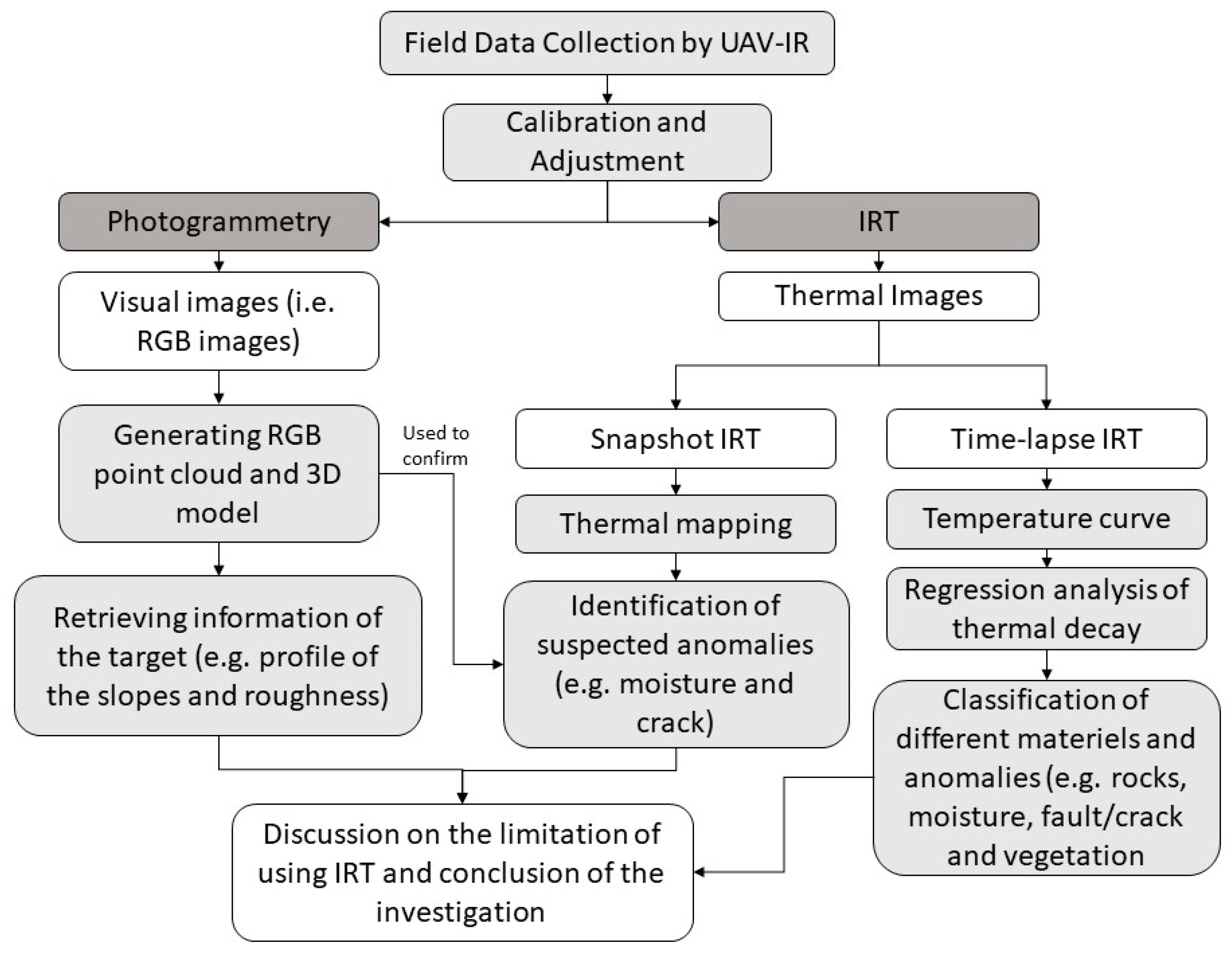
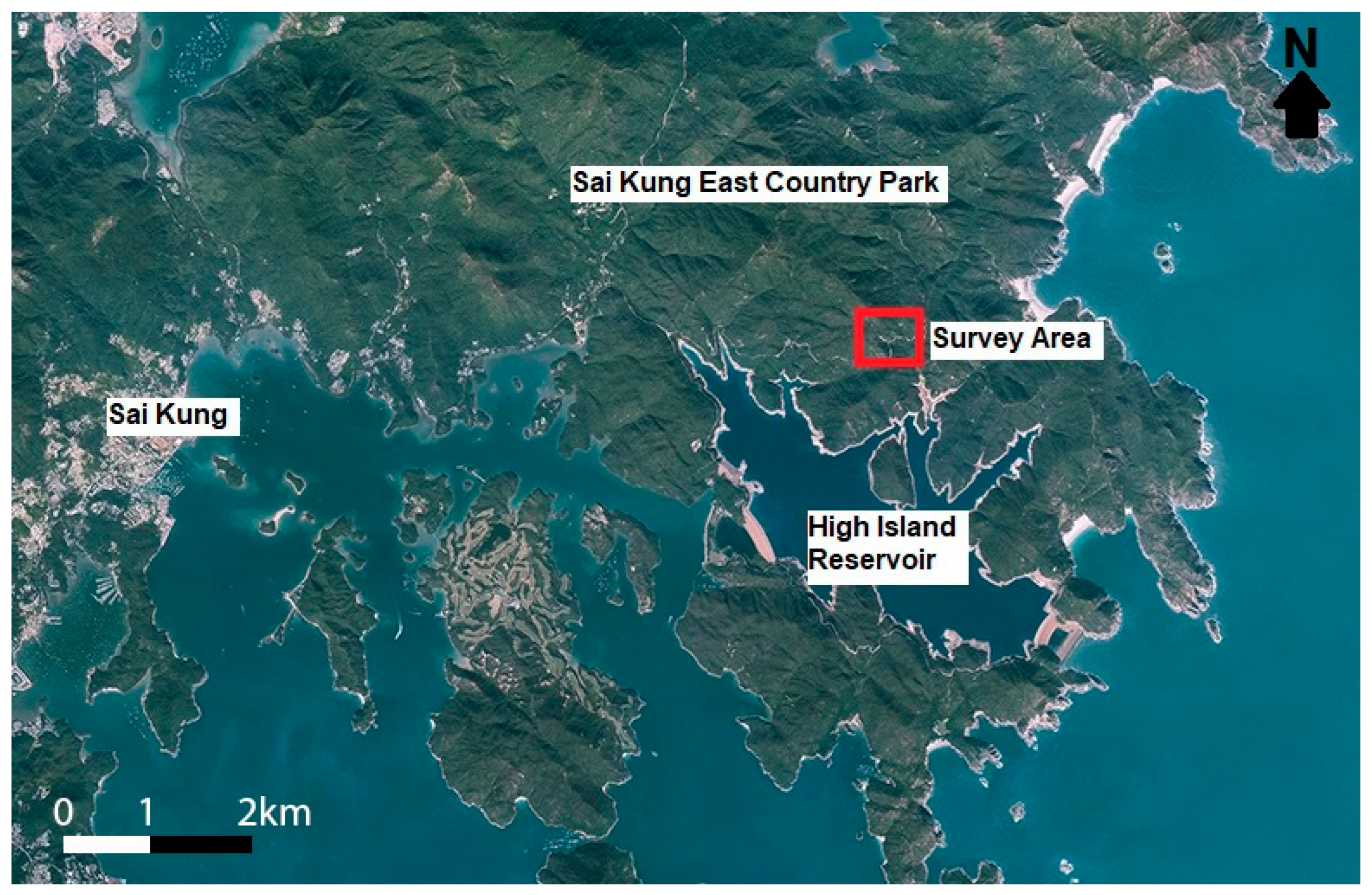


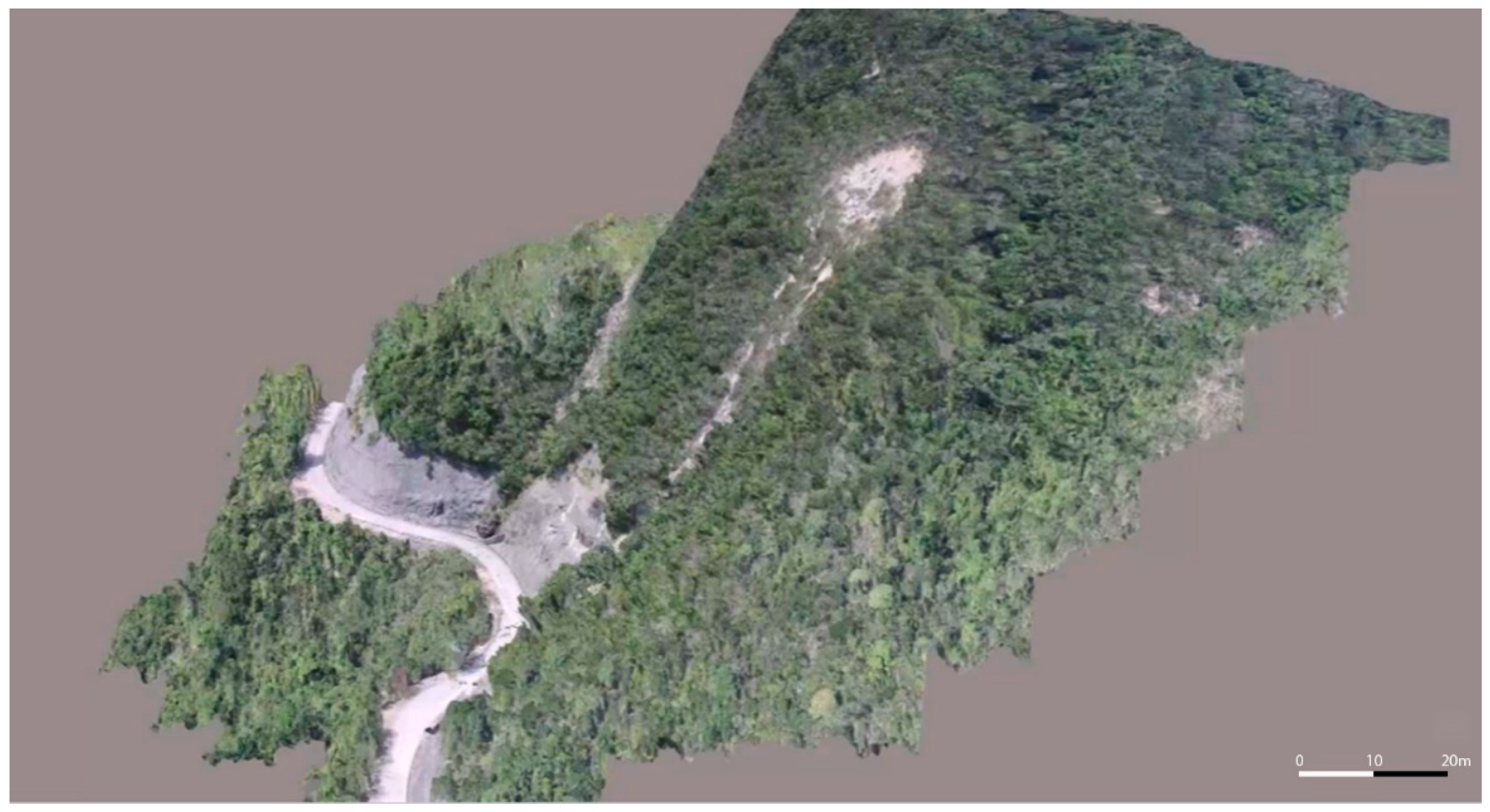
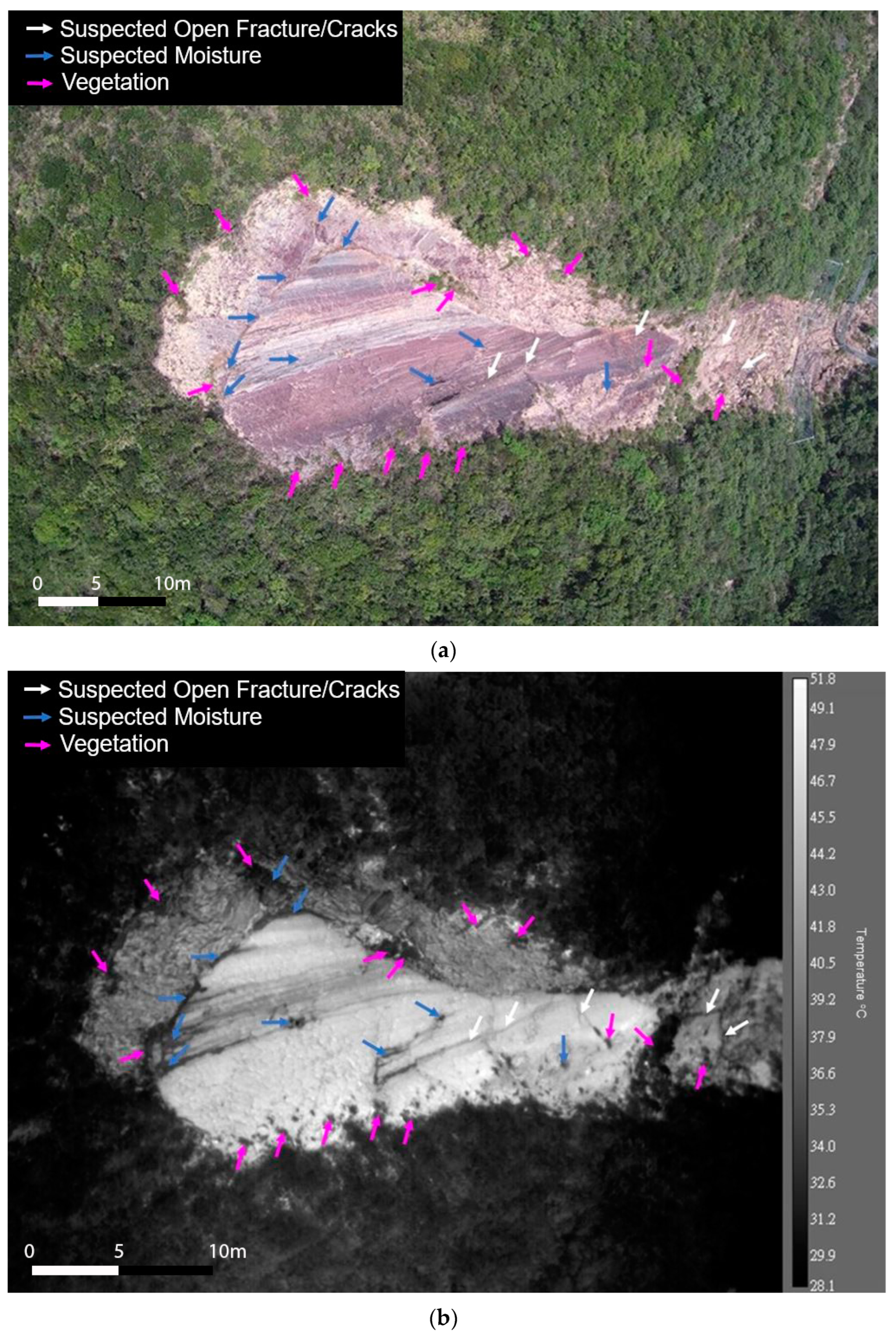
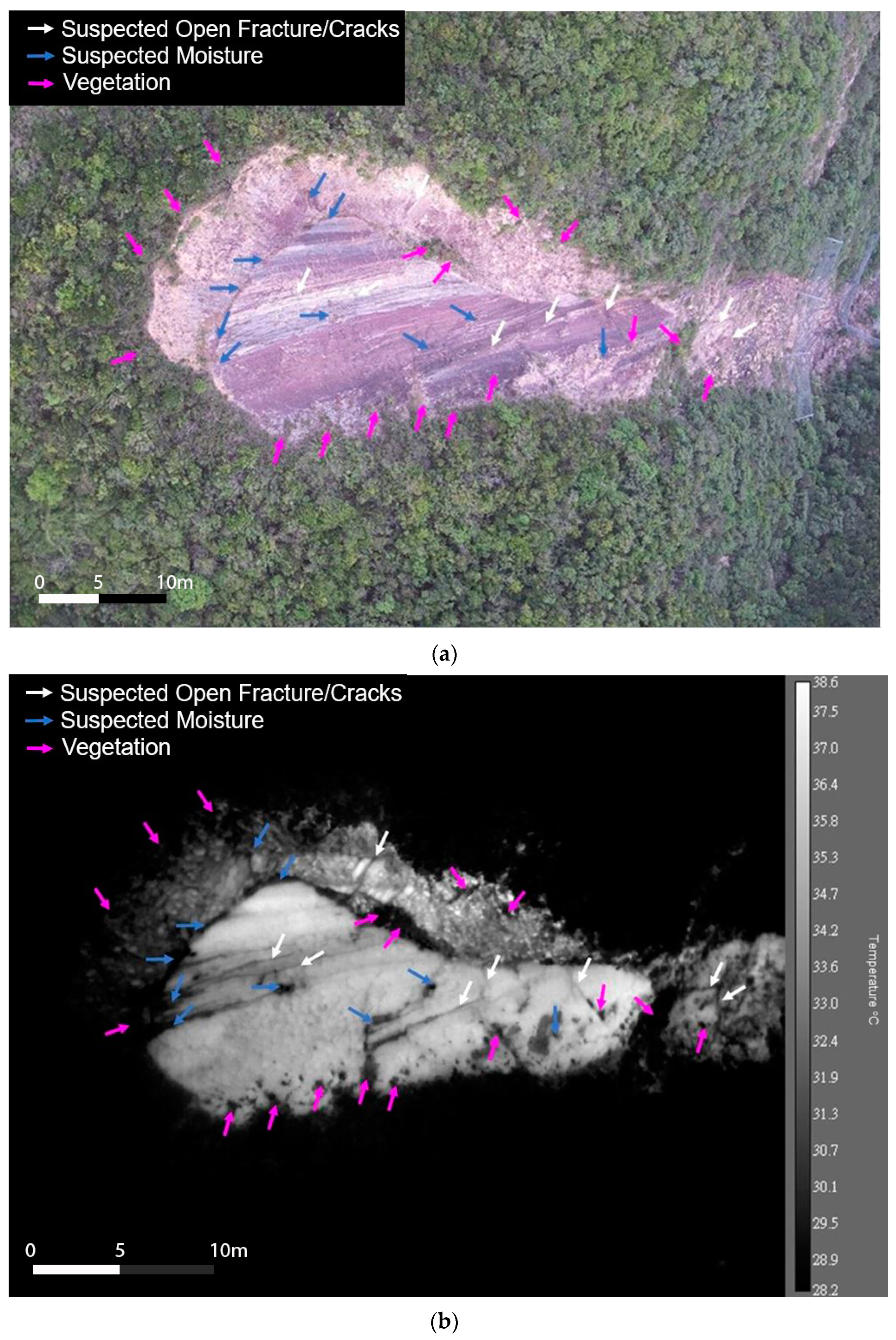
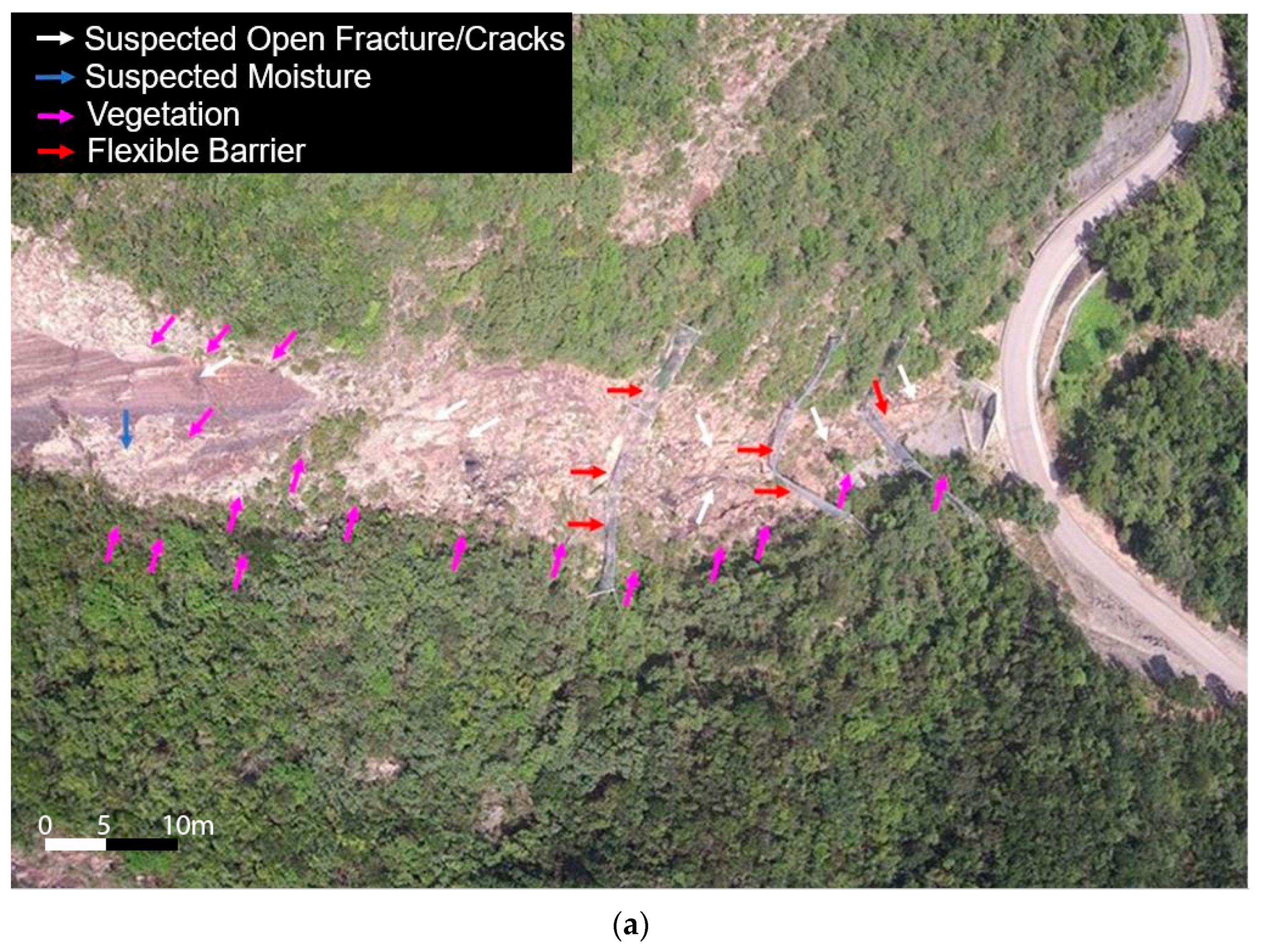
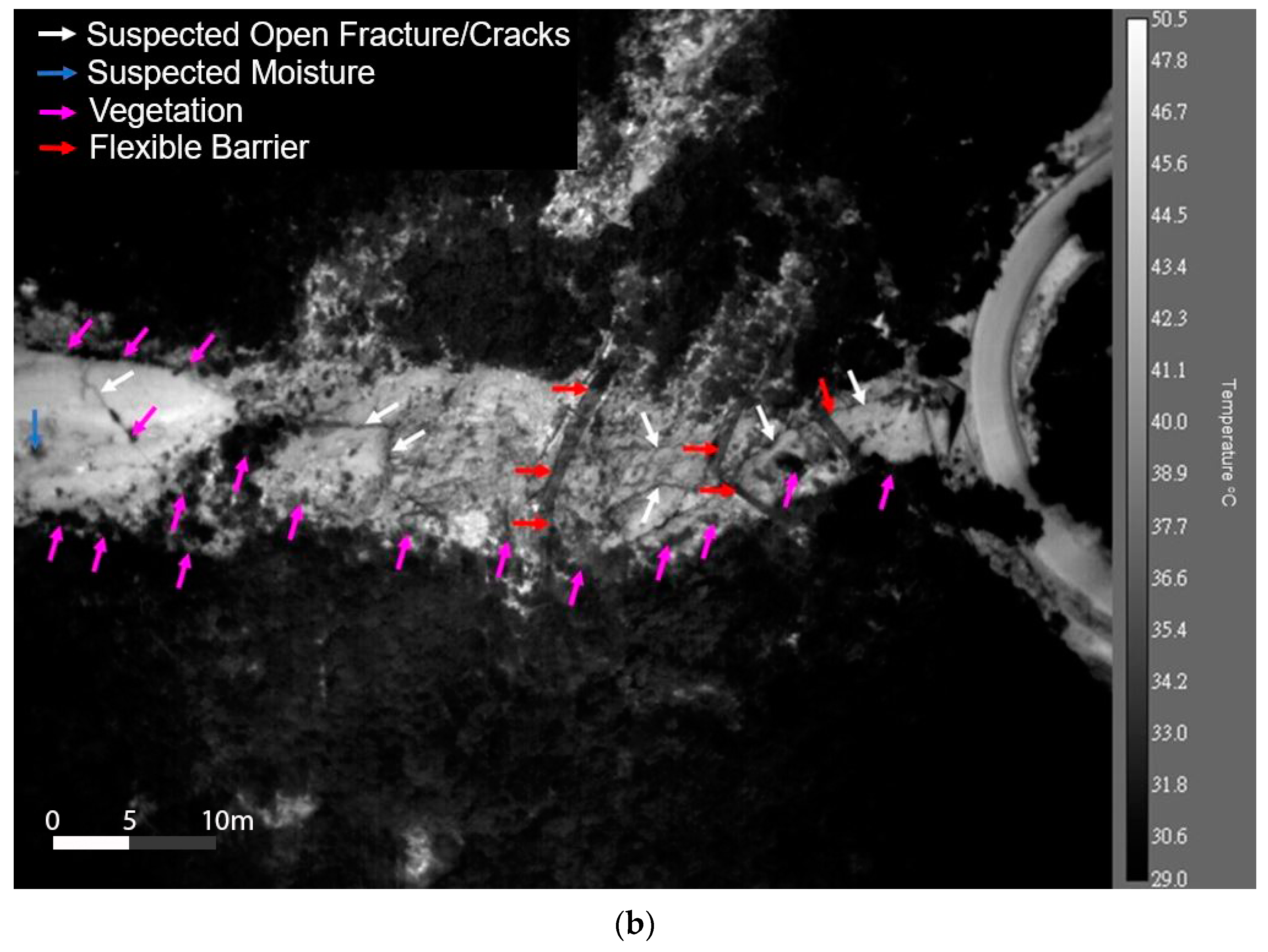
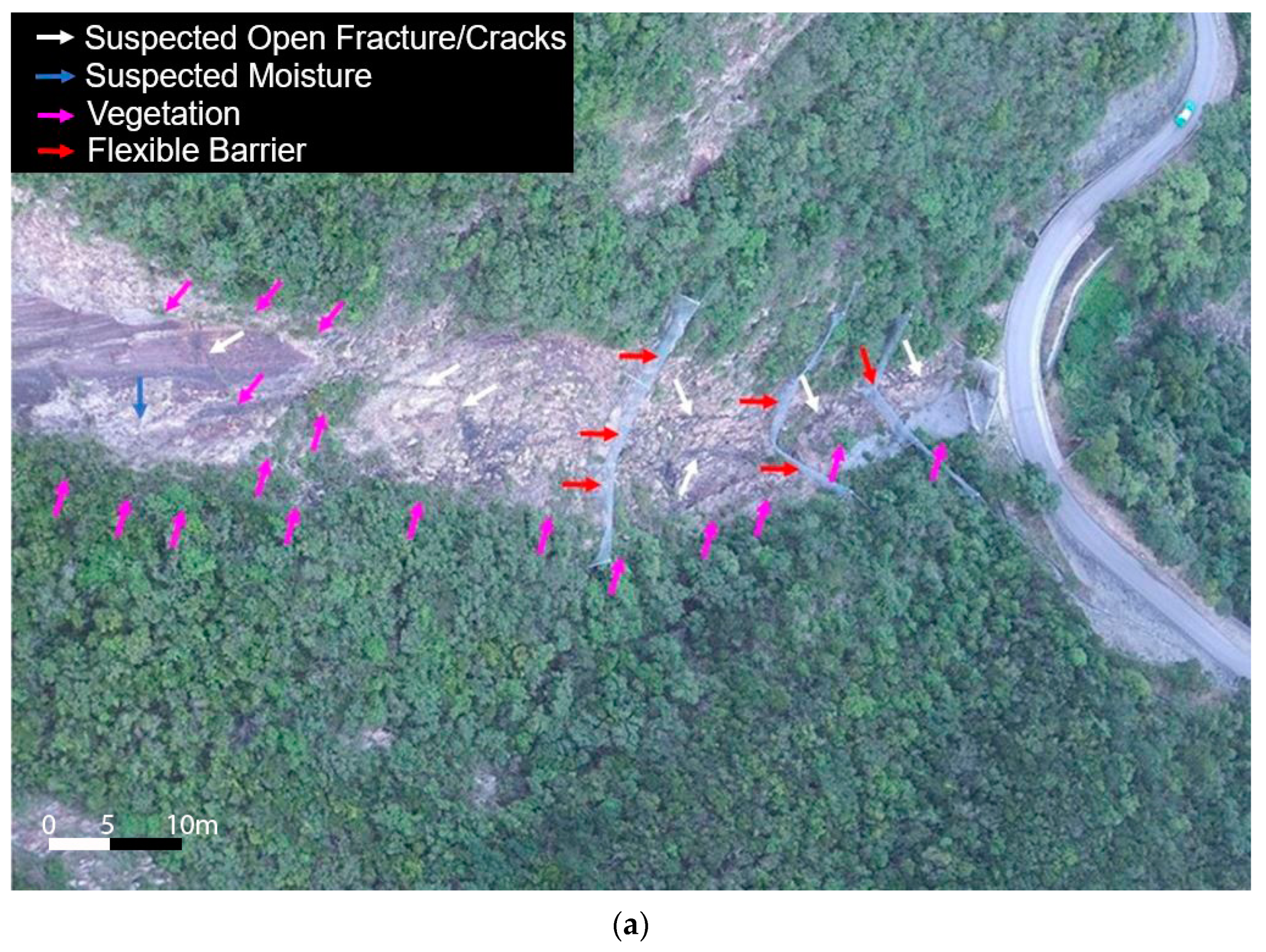

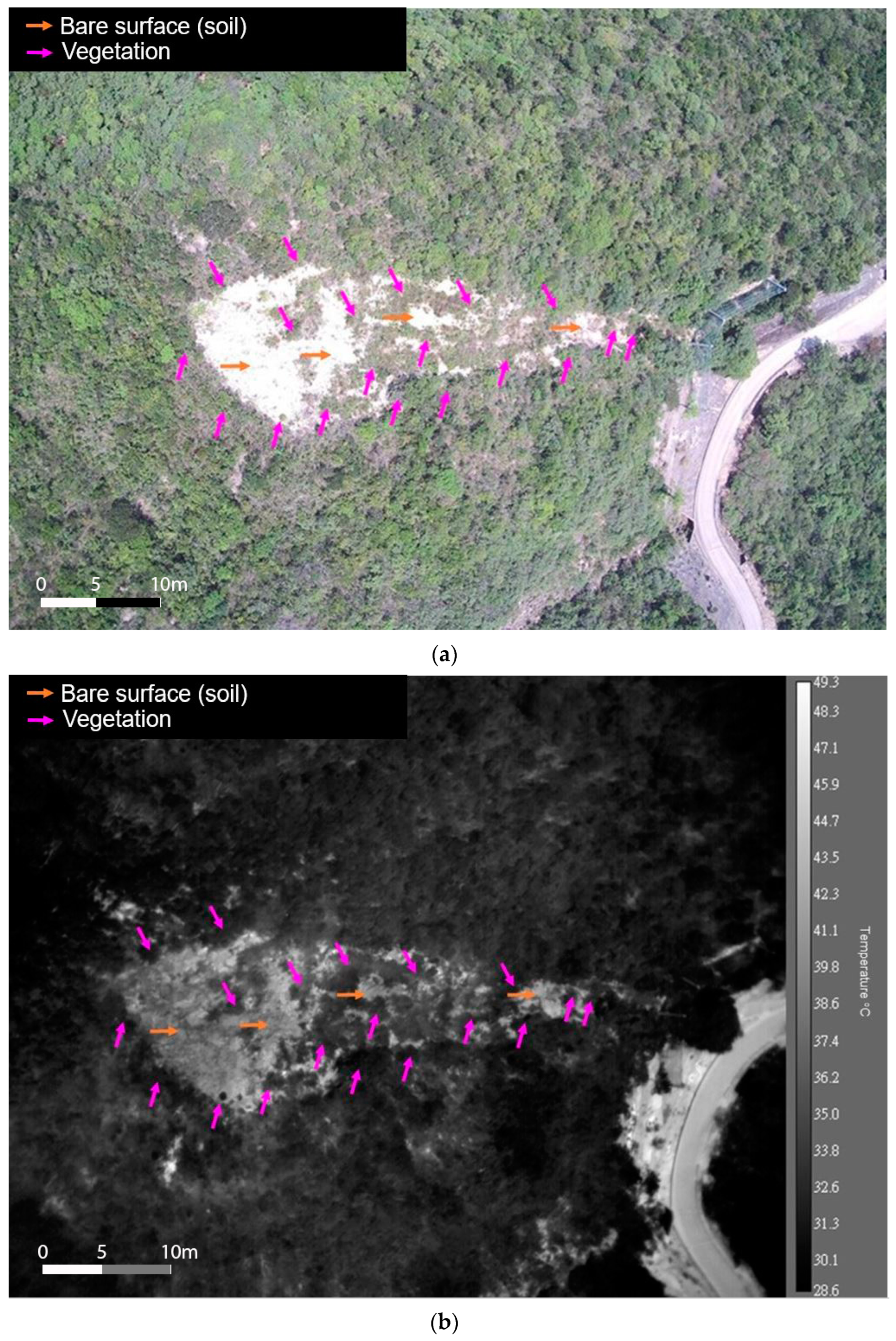

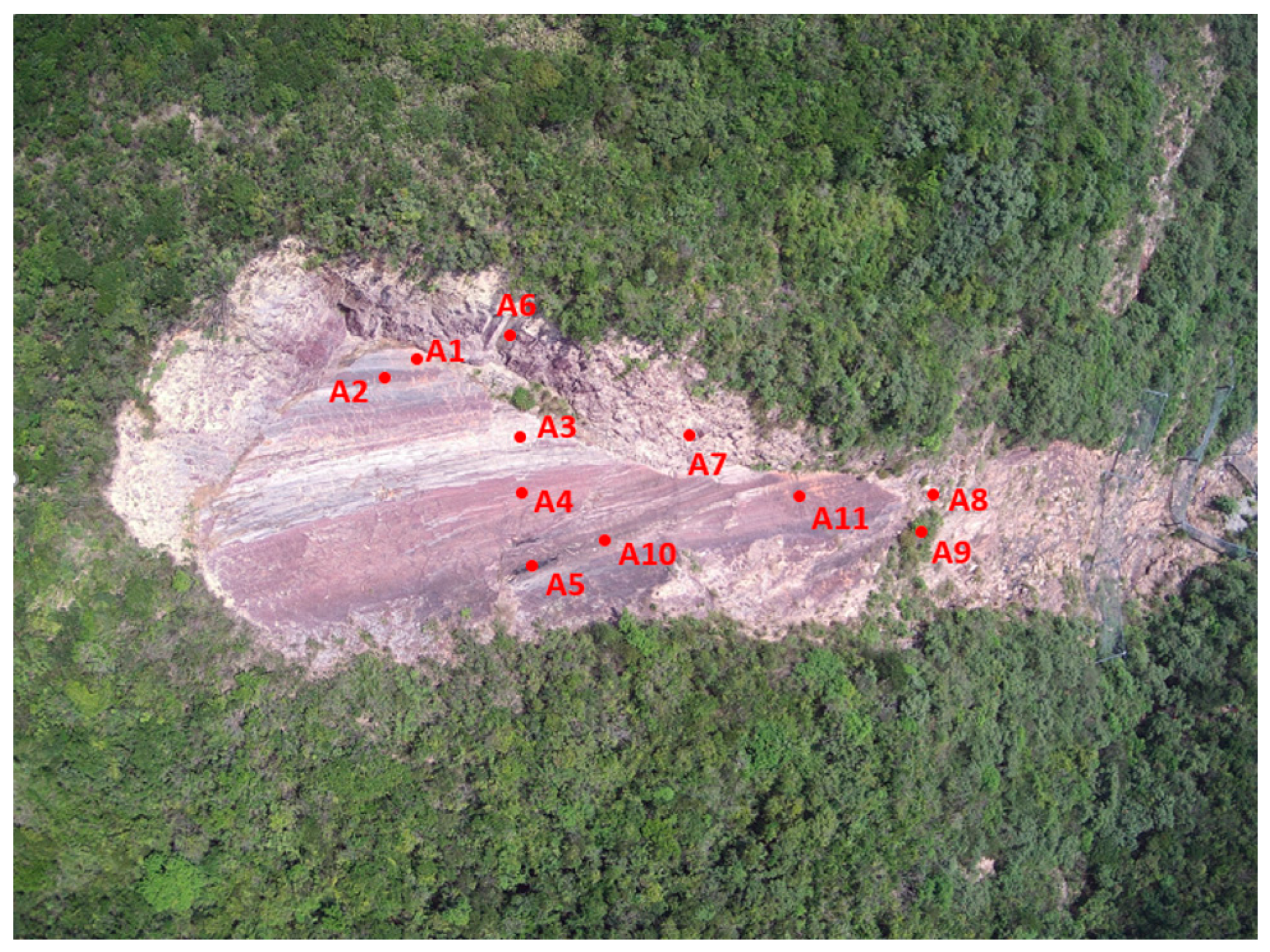


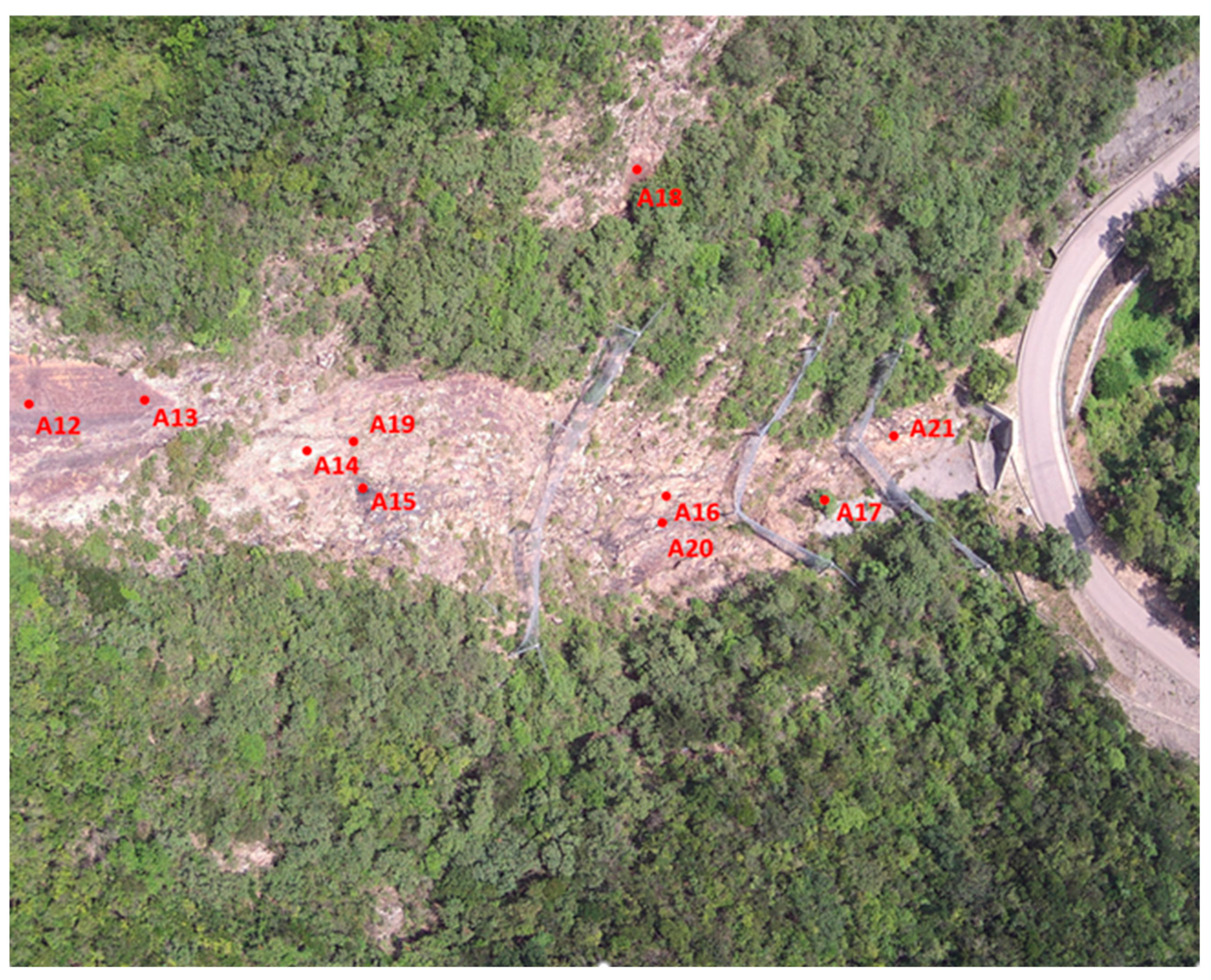
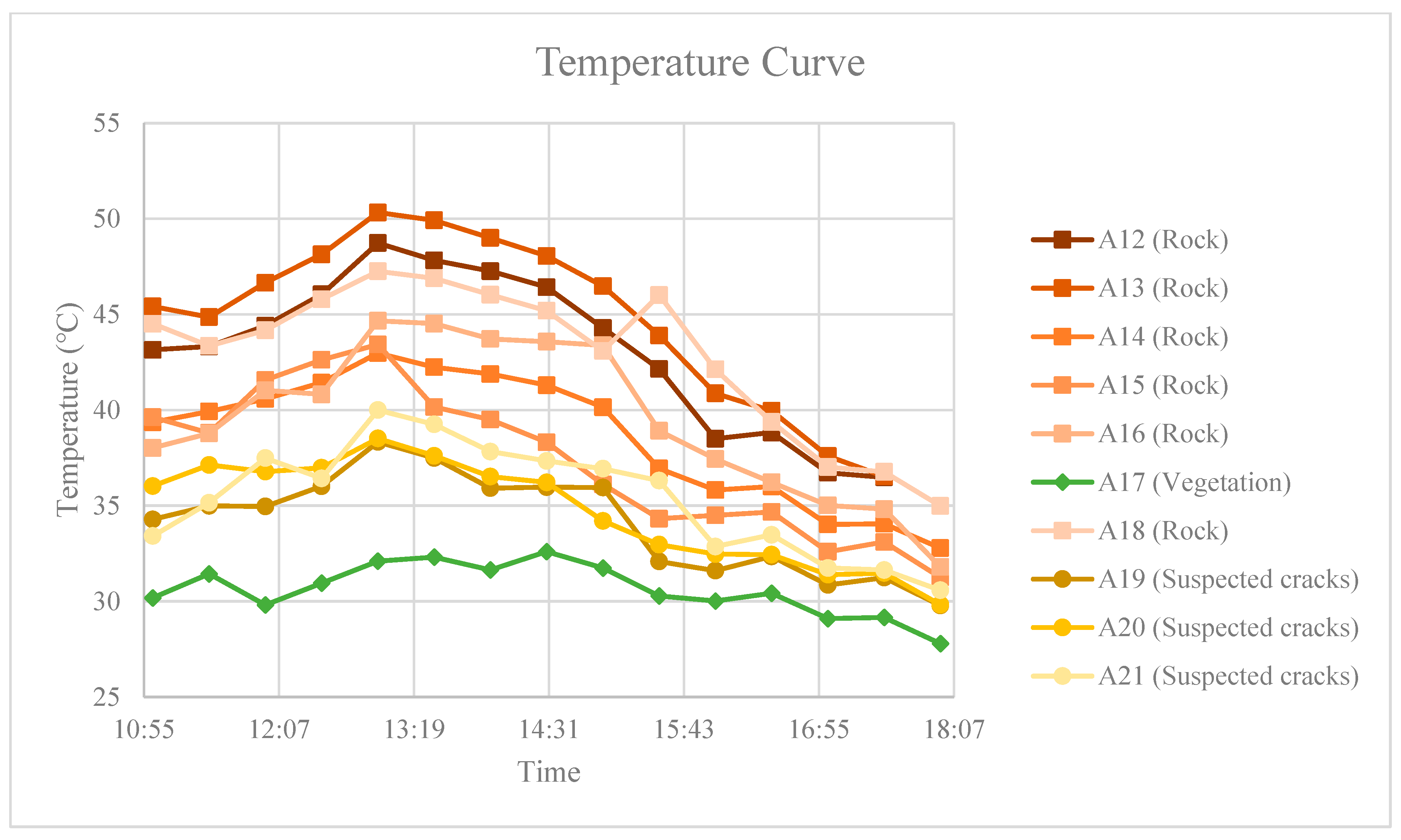
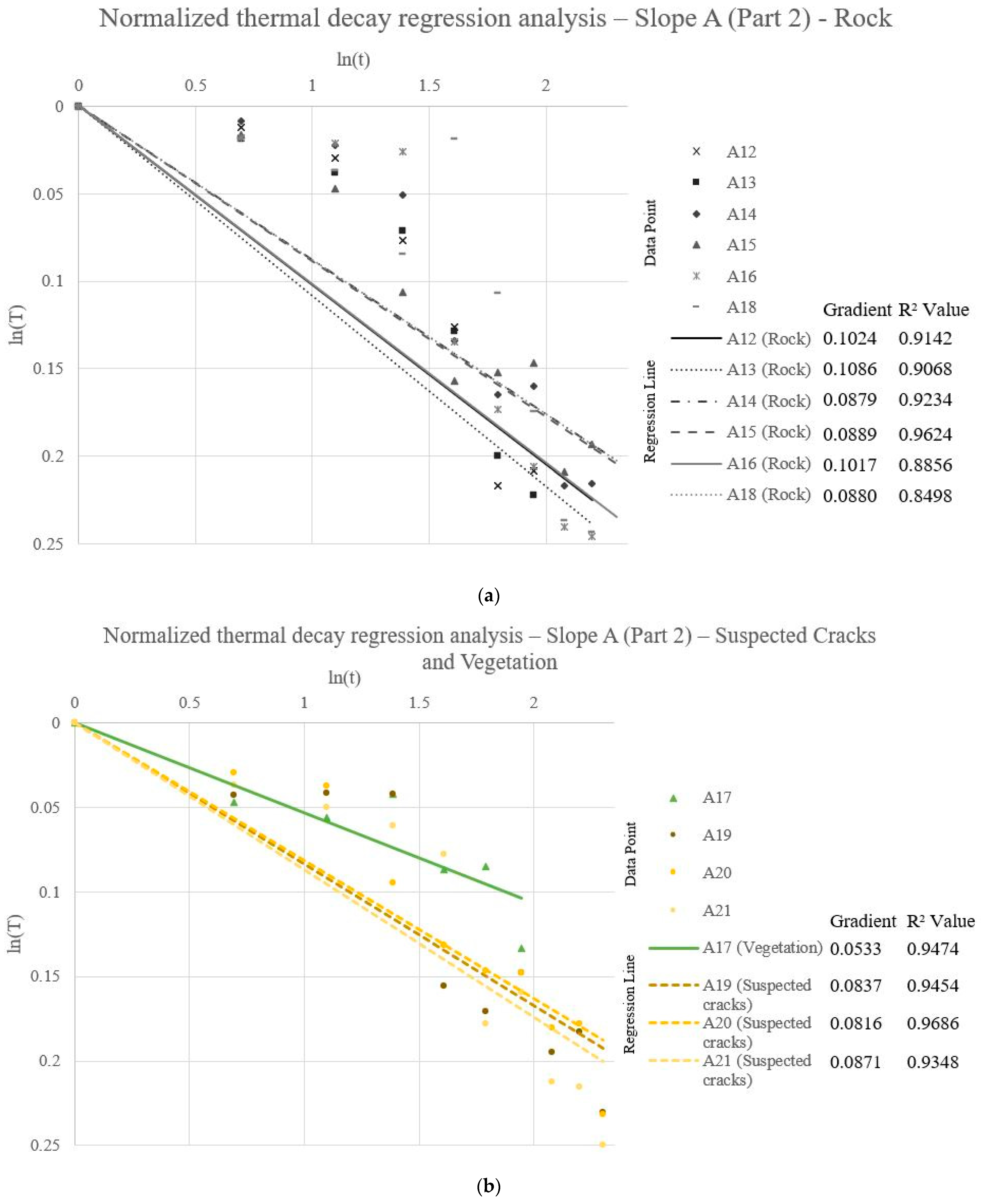
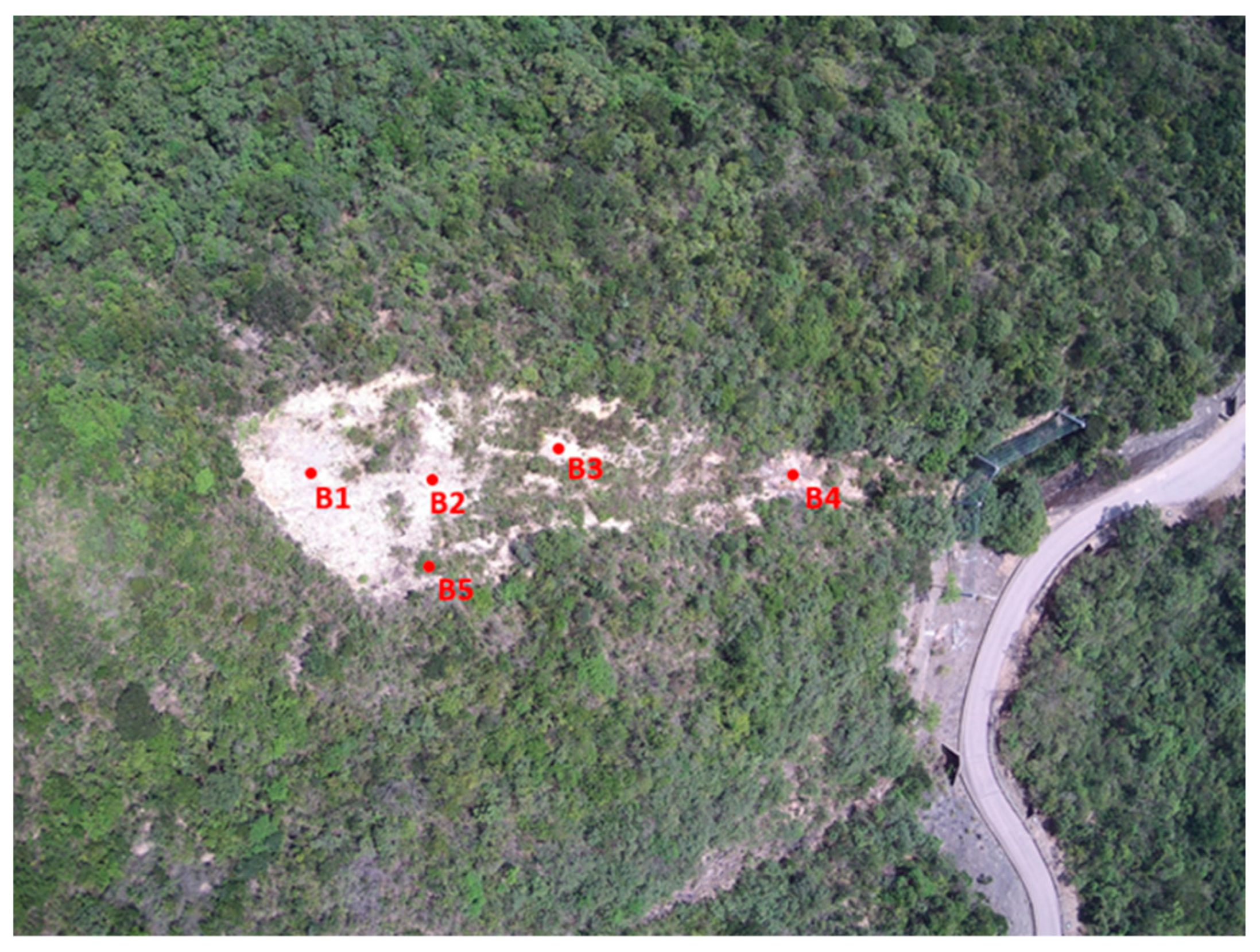
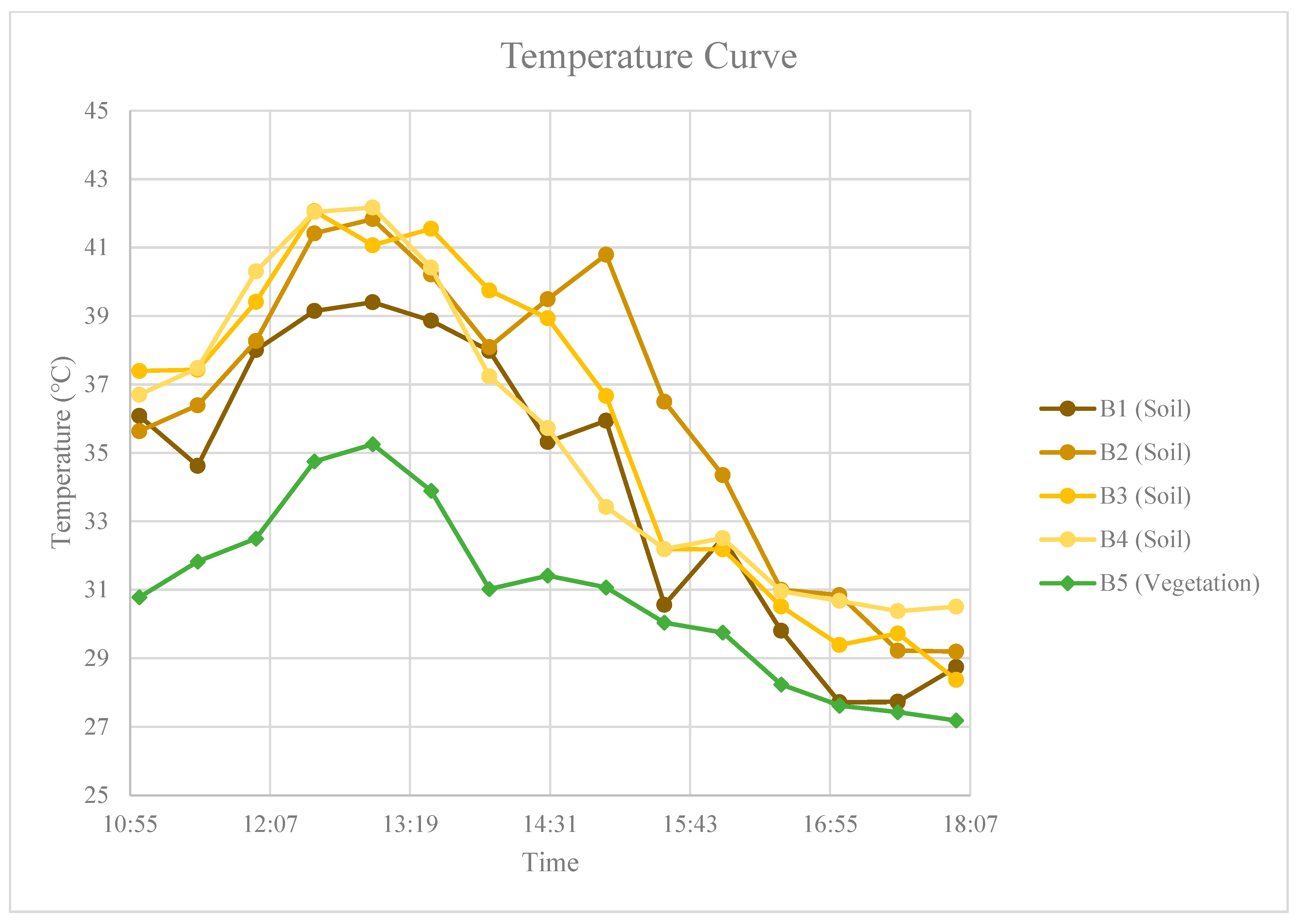
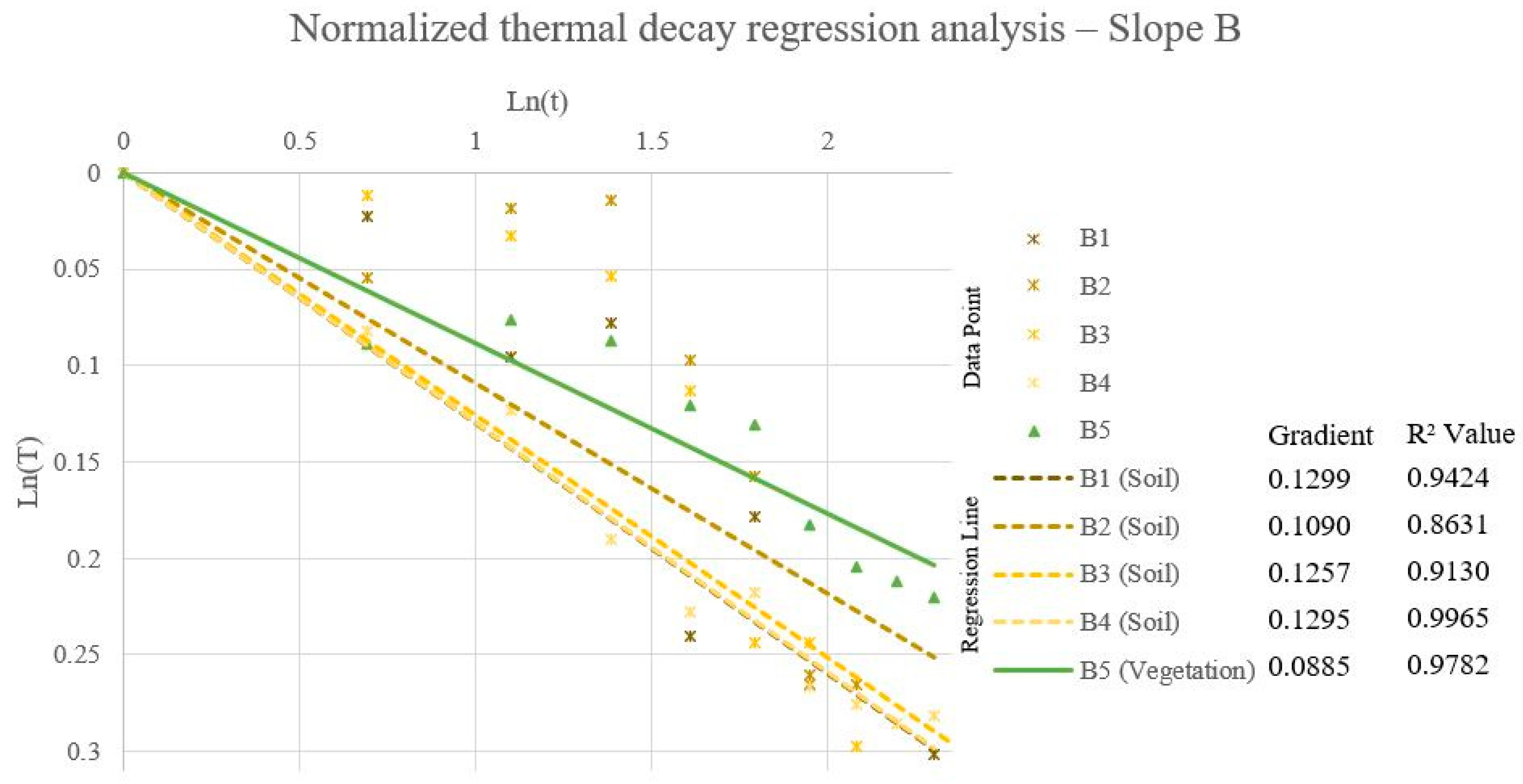
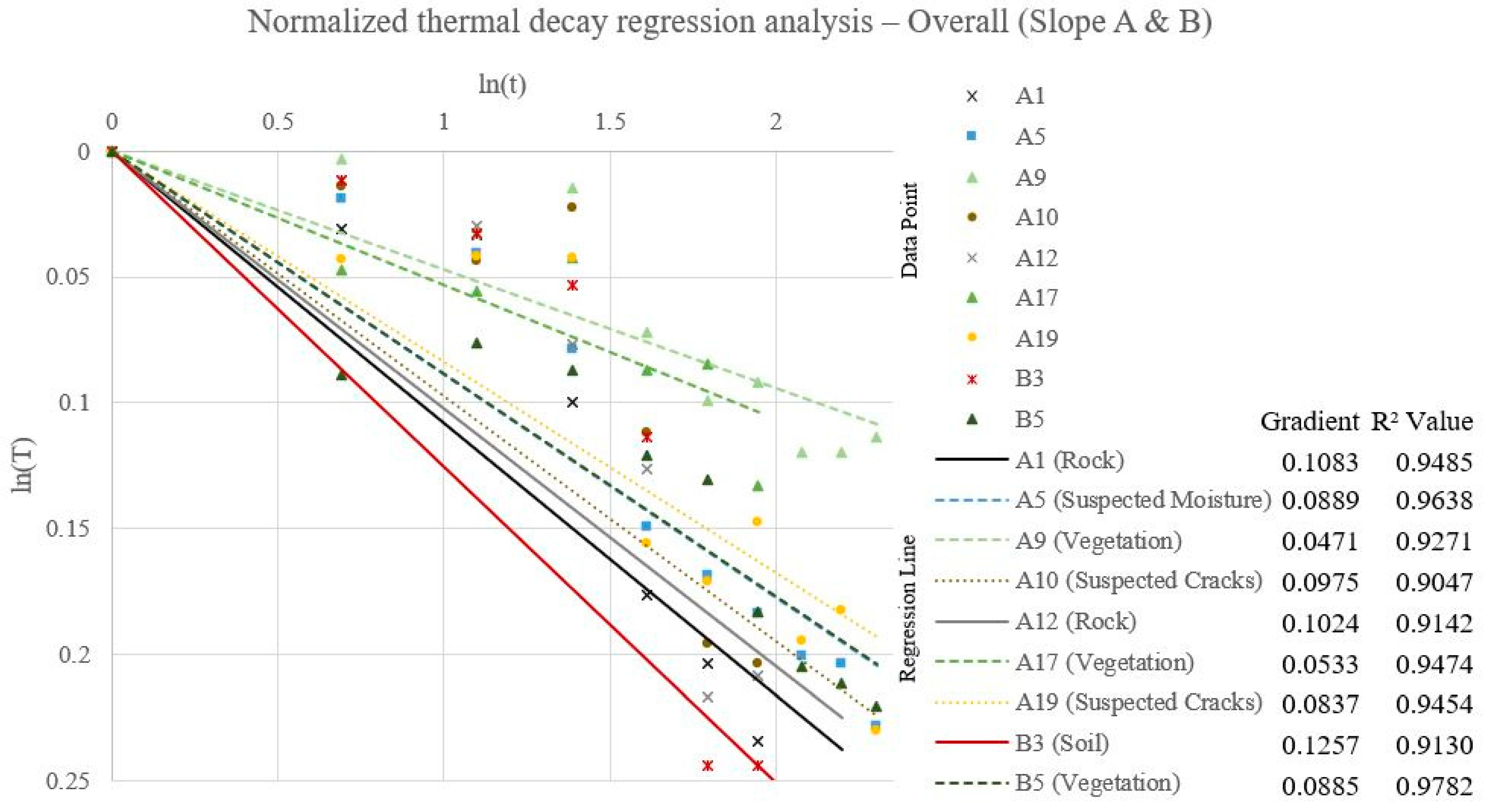


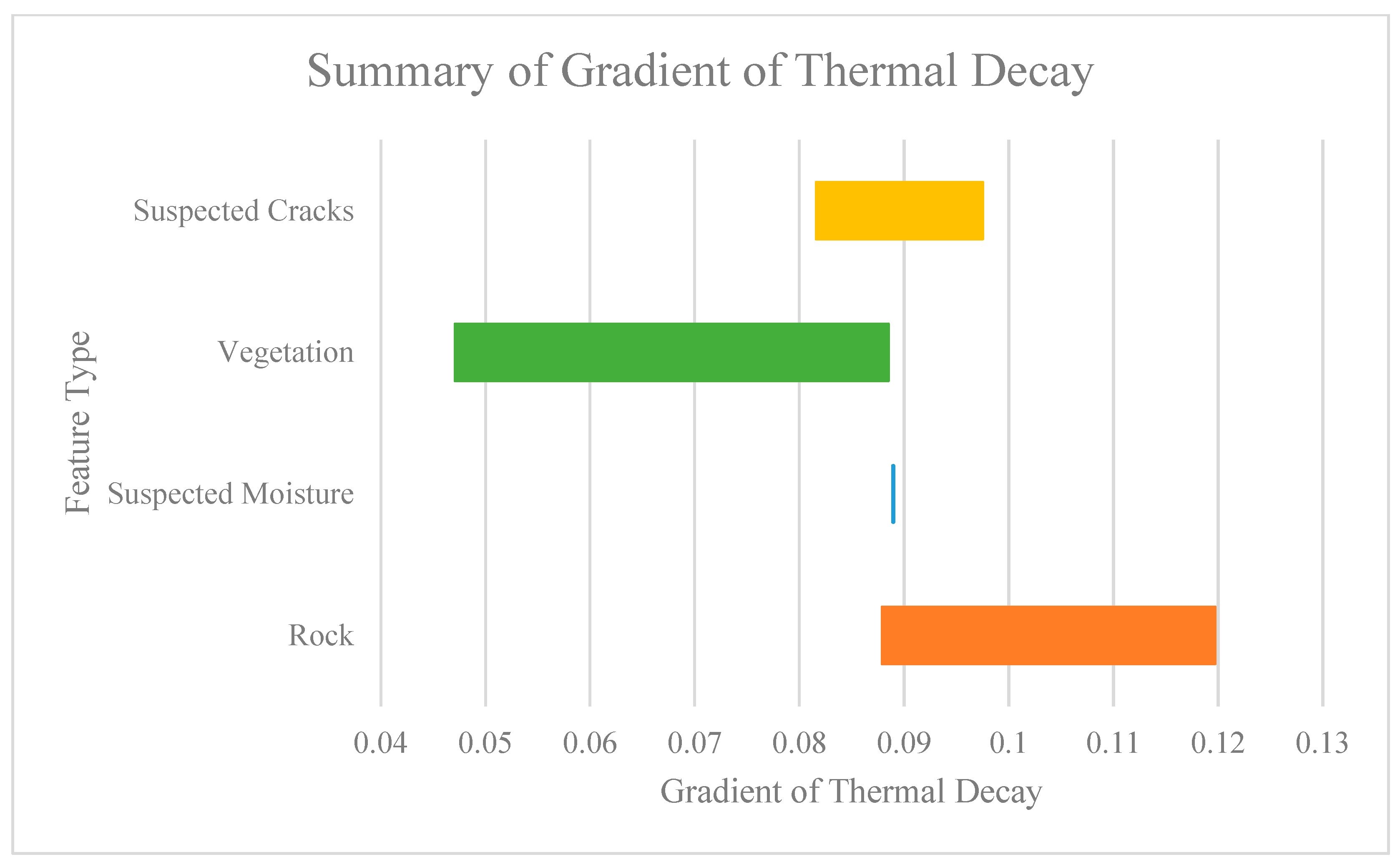
| Model | Lens (mm) | Frequency (Hz) | Resolution | Sensitivity (mK) | FOV | IFOV (in Mrad) |
|---|---|---|---|---|---|---|
| Zenmuse XT2 | 13 | 9 | 640 × 512 | 50 | 45° × 37° | 1.308 |
| Model | Max Takeoff Weight (kg) | Hovering Accuracy (m) | Max Angular Velocity (°/s) | Max Speed (Dual Downward Gimbals) (kph) | Max Wind Resistance (m/s) |
|---|---|---|---|---|---|
| DJI M210 | 6.14 | Vertical: ±0.5, Downward Vision System enabled: ±0.1 Horizontal: ±1.5, Downward Vision System enabled: ±0.3 | Pitch: 300; Yaw: 150 | S Mode: 64.8; P Mode: 61.2; A Mode: 61.2 | 12 |
Disclaimer/Publisher’s Note: The statements, opinions and data contained in all publications are solely those of the individual author(s) and contributor(s) and not of MDPI and/or the editor(s). MDPI and/or the editor(s) disclaim responsibility for any injury to people or property resulting from any ideas, methods, instructions or products referred to in the content. |
© 2023 by the authors. Licensee MDPI, Basel, Switzerland. This article is an open access article distributed under the terms and conditions of the Creative Commons Attribution (CC BY) license (https://creativecommons.org/licenses/by/4.0/).
Share and Cite
Chiu, L.S.-Y.; Lai, W.W.-L.; Santos-Assunção, S.; Sandhu, S.S.; Sham, J.F.-C.; Chan, N.F.-S.; Wong, J.C.-F.; Leung, W.-K. A Feasibility Study of Thermal Infrared Imaging for Monitoring Natural Terrain—A Case Study in Hong Kong. Remote Sens. 2023, 15, 5787. https://doi.org/10.3390/rs15245787
Chiu LS-Y, Lai WW-L, Santos-Assunção S, Sandhu SS, Sham JF-C, Chan NF-S, Wong JC-F, Leung W-K. A Feasibility Study of Thermal Infrared Imaging for Monitoring Natural Terrain—A Case Study in Hong Kong. Remote Sensing. 2023; 15(24):5787. https://doi.org/10.3390/rs15245787
Chicago/Turabian StyleChiu, Lydia Sin-Yau, Wallace Wai-Lok Lai, Sónia Santos-Assunção, Sahib Singh Sandhu, Janet Fung-Chu Sham, Nelson Fat-Sang Chan, Jeffrey Chun-Fai Wong, and Wai-Kin Leung. 2023. "A Feasibility Study of Thermal Infrared Imaging for Monitoring Natural Terrain—A Case Study in Hong Kong" Remote Sensing 15, no. 24: 5787. https://doi.org/10.3390/rs15245787
APA StyleChiu, L. S.-Y., Lai, W. W.-L., Santos-Assunção, S., Sandhu, S. S., Sham, J. F.-C., Chan, N. F.-S., Wong, J. C.-F., & Leung, W.-K. (2023). A Feasibility Study of Thermal Infrared Imaging for Monitoring Natural Terrain—A Case Study in Hong Kong. Remote Sensing, 15(24), 5787. https://doi.org/10.3390/rs15245787








